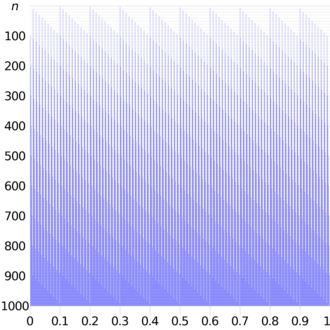Van der Corput sequence

A van der Corput sequence is an example of the simplest one-dimensional low-discrepancy sequence over the unit interval; it was first described in 1935 by the Dutch mathematician J. G. van der Corput. It is constructed by reversing the base-n representation of the sequence of natural numbers (1, 2, 3, …).
The -ary representation of the positive integer is where is the base in which the number is represented, and that is, the -th digit in the -ary expansion of The -th number in the van der Corput sequence is
Examples
For example, to get the decimal van der Corput sequence, we start by dividing the numbers 1 to 9 in tenths (), then we change the denominator to 100 to begin dividing in hundredths (). In terms of numerator, we begin with all two-digit numbers from 10 to 99, but in backwards order of digits. Consequently, we will get the numerators grouped by the end digit. Firstly, all two-digit numerators that end with 1, so the next numerators are 01, 11, 21, 31, 41, 51, 61, 71, 81, 91. Then the numerators ending with 2, so they are 02, 12, 22, 32, 42, 52, 62, 72, 82, 92. And after that, the numerators ending in 3: 03, 13, 23 and so on...
Thus, the sequence begins or in decimal representation:
- 0.1, 0.2, 0.3, 0.4, 0.5, 0.6, 0.7, 0.8, 0.9, 0.01, 0.11, 0.21, 0.31, 0.41, 0.51, 0.61, 0.71, 0.81, 0.91, 0.02, 0.12, 0.22, 0.32, …,
The same can be done for the binary numeral system, and the binary van der Corput sequence is
- 0.12, 0.012, 0.112, 0.0012, 0.1012, 0.0112, 0.1112, 0.00012, 0.10012, 0.01012, 0.11012, 0.00112, 0.10112, 0.01112, 0.11112, …
or, equivalently,
The elements of the van der Corput sequence (in any base) form a dense set in the unit interval; that is, for any real number in , there exists a subsequence of the van der Corput sequence that converges to that number. They are also equidistributed over the unit interval.
C implementation
double corput(int n, int base){
double q=0, bk=(double)1/base;
while (n > 0) {
q += (n % base)*bk;
n /= base;
bk /= base;
}
return q;
}
See also
- Bit-reversal permutation – Permutation that reverses binary numbers
- Halton sequence – Type of numeric sequence used in statistics, a natural generalization of the van der Corput sequence to higher dimensions
References
- van der Corput, J.G. (1935), "Verteilungsfunktionen (Erste Mitteilung)" (in German), Proceedings of the Koninklijke Akademie van Wetenschappen te Amsterdam 38: 813–821, http://www.dwc.knaw.nl/DL/publications/PU00014607.pdf
- Kuipers, L.; Niederreiter, H. (2005), Uniform distribution of sequences, Dover Publications, p. 129,158, ISBN 0-486-45019-8
External links
 |
